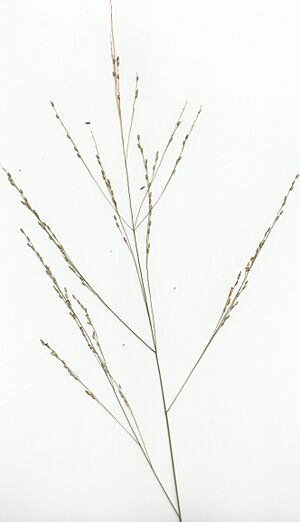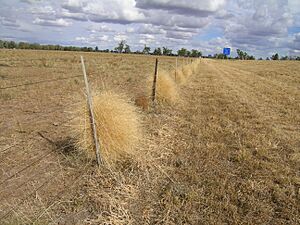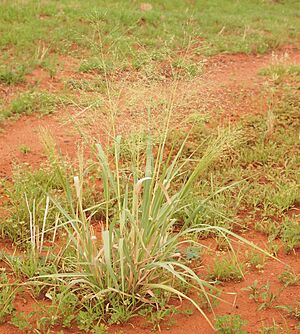Native millet facts for kids
Quick facts for kids Native millet |
|
|---|---|
 |
|
| Scientific classification | |
| Genus: |
Panicum
|
| Species: |
decompositum
|
Panicum decompositum, often called native millet, native panic, Australian millet, papa grass, or umbrella grass, is a type of perennial grass. This means it lives for more than two years. It grows naturally in the dry inland parts of Australia and can be found in every mainland state. People can collect its seeds to make flour, which is a traditional bushfood for Aboriginal people. Farmers also like this grass because animals enjoy eating it, making it good for grazing areas.
Contents
Description
Native millet is a special type of grass that forms clumps, called tussocks. Its leaves are blue-green and look like blades, with a pale line down the front. On the back of the leaves, there's a raised part called a keel. This grass can grow quite tall, up to 145 centimeters (about 4.7 feet). Its seed heads can be around 40 centimeters (about 1.3 feet) long.
Native millet flowers have both male and female parts in the same flower. This is called being hermaphroditic. The seed head looks like an open cluster with many small branches. At the end of each branch, there's a tiny flower part called a spikelet. These spikelets grow into seeds. The grass flowers in summer and autumn, usually from December to May in Australia. Wind helps to spread its pollen, which is how it reproduces.
Like many grasses, native millet has fibrous roots. These roots spread out like a net, holding the soil in place and stopping it from washing away. They also help the soil stay healthy by providing a home for tiny living things. This helps to clean water that runs off the land, like water with fertilizers or pesticides.
How it Spreads
The main way native millet seeds spread is by wind. When the seeds are ready and dry, the spikelets can easily break off. The wind then blows them to new places. Sometimes, these dry spikelets and dead stalks can gather together. This can create a fire risk. To help prevent large bushfires, people often use backburning. This is when small, controlled fires are set to burn away dry plants.
Where it Grows
Native millet can grow in many different types of soil. However, it likes wetter soils that have a lot of clay and sand. These are often called alluvial soil. You can find native millet spread out evenly in fields, rather than growing in big, dense patches. This grass is tough and can survive both very dry times (drought) and floods. It can even handle long periods of flooding without much harm, though new seedlings might grow slower. Native millet doesn't like frost and often stops making seeds in winter. But it can grow back quickly in spring.
How People Use It
As Bushfood
Native millet is a very important food for Aboriginal people living in the outback. They collect the seeds by hand. Then, they grind them into flour to make damper, a traditional type of bread. Sometimes, they mix native millet seeds with other native seeds, like wattle seeds or Spinifex grass seeds.
The seed heads often have enough moisture to make a dough when ground. If not, a little water can be added to make a thick, sticky paste. This dough can be eaten raw. Or, it can be shaped into a loaf or bun and cooked on hot coals. This cooked bread is known as bush bread, seed cake, or soda bread. Bush bread is often carried on long journeys to provide energy. Some bakeries in Australia are even starting to use native millet and other native grasses, like kangaroo grass, in their modern baking. They use them as an alternative to wheat or rye flour.
For Farming Animals
Farmers also value native millet as food for their livestock, such as sheep or cattle. It has a good amount of protein, usually between 2.2% and 10.6%. Animals generally find it tasty. Because it can handle floods, this grass can produce a lot of food in floodplains after heavy rains or floods in summer.
Native millet can handle many animals grazing on it. But it's best to manage it by moving animals around, a method called rotational grazing. This means letting animals eat no more than 40% of the grass at one time. If too much grass grows, the bottom parts can start to rot, making it less appealing to animals. If native millet grows on sandy soil, it usually means not too many animals are grazing there. But if it grows on clay soil, it might mean too many animals are grazing. Studies have shown that native millet seeds grow better after being exposed to smoke from plants. This suggests that backburning or planting smoke-treated seeds could help create better pastures for animals or for growing seeds.
Is it Poisonous?
Some types of Panicum grass, like Panicum dichotomiflorum, are known to cause a skin problem in animals like sheep. This problem is called hepatogenous photosensitisation. It happens when a substance builds up in the animal's body and makes their skin very sensitive to sunlight. This can lead to sunburn, blisters, or sores. P. decompositum has been thought to be poisonous in a similar way, but there haven't been any confirmed cases.
Where You Can Find It
There are two slightly different types of native millet. One type, P. decompositum var. decompositum, only grows naturally in Victoria, Australia. The other type, P. decompositum var. tenuis, grows in all other mainland states. This includes the Northern Territory, Queensland, South Australia, and New South Wales. Not many sightings have been reported in South Australia. Neither type is found in Tasmania.
Native millet is also found in the Mitchell grasslands of the Kimberly region in Western Australia. These grasslands are known for their dark soil, which has a lot of clay and silt.




